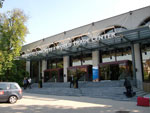
For Release: April 10, 2012
AES 132nd Convention Offers Prolific Paper/Poster Presentations
The Hand Clap As An Impulse Source, Virtual Microphones & Audio For Games
BUDAPEST: Over one hundred enlightening Paper and Poster presentations have been developed for the 132nd Audio Engineering Society Convention set for the Novotel Budapest Congress & World Trade Center April 26-29. Leaders throughout the international professional audio community will gather to exchange ideas, and take maximum advantage of the Convention’s unique networking opportunities. Highlights of the varied Paper and Poster schedule include:
The Hand Clap as an Impulse Source for Measuring Room Acoustic: Authors - Prem Seetharaman and Stephen P. Tarzia tested the suitability of hand clap recordings for measuring several acoustic features of musical performance and recording rooms. Their goal was to make acoustic measurement possible for amateur musicians and hobbyists through the use of a smartphone or web app. Using their technique, measuring a room's reverberation times and frequency response is as easy as starting a smartphone app and clapping several times.
Emerging and Innovative Audio Virtual Microphones - Using Ultrasonic Sound to Receive Audio Waves: Authors - Tobias Merkel, Hans Lühmann, and Tom Ritter will discuss their research with highly focused ultrasound beams and microphones. They overlaid the wave field of a common audio source with an ultrasonic beam. They discovered that the phase shift of the received signal obtains the audio information of the overlaid field. Since the ultrasonic beam itself acts as sound receiver, no technical device e.g. membranes, are necessary in the direct vicinity of sound reception. Because this type of sound receiver is not visible or touchable they describe it as a “Virtual Microphone.”
Audio for Games and Mobile/PDA, Efficient Binaural Audio Rendering Using Independent Early and Diffuse Paths: Author - Fritz Menzer A multi-source binaural audio rendering structure is proposed that efficiently implements plausible binaural reverberation including early reflections and late reverberation. The structure contains delay lines and, a feedback delay network that operate independently, modeling early reflections and diffuse reverberation, respectively. Computationally efficient heuristics are presented for the implementation of an HRTF set and, for the diffuse reverberation, a real-time implementation on a mobile device will be presented.
Please visit http://www.aes.org/events/132/calendar/calendar.cfm for a complete list of event titles, abstracts and presentation times.
Photo: The Budapest Congress & World Trade Center hosts the 132nd AES Convention April 26-29.
###
The Audio Engineering Society was formed in 1948 by a group of concerned audio engineers. With over 14,000 members throughout the U.S., Latin America, Europe, Japan and the Far East, the organization serves as the pivotal force in the exchange and dissemination of technical information for the industry. For additional information visit http://www.aes.org

